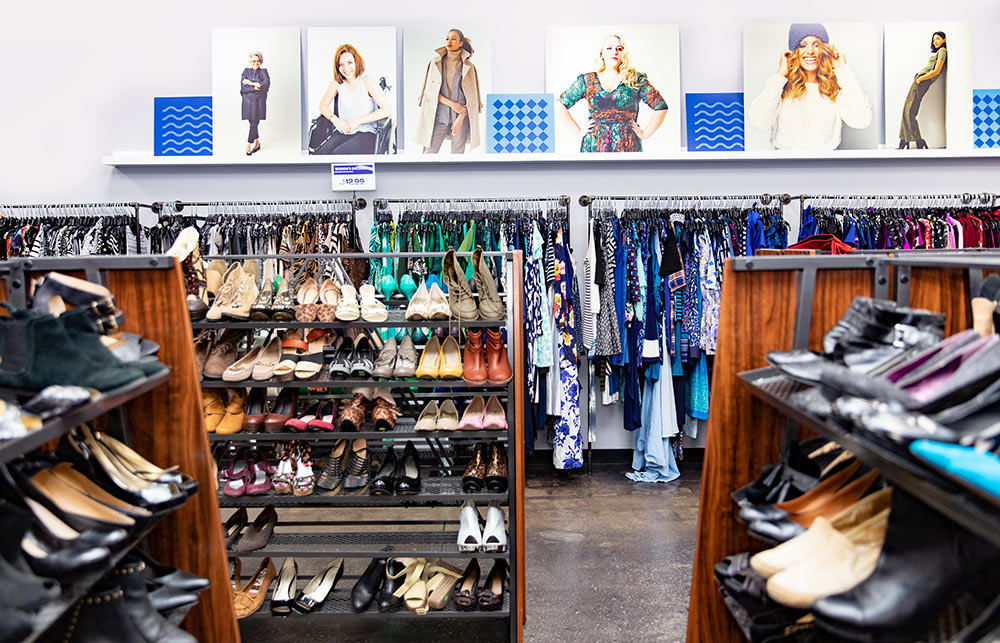二手货交易兴隆,这家公司趁机重塑
上周,在布鲁克林中心区的Goodwill慈善商店里——就在纽约市恢复到店购物的第二天——顾客源源不断地走进店里,在保持社交距离的同时,从货架上拿起裙子衬衫,精心挑选餐具套装,投身于他们已经期待了好几个星期的淘宝式购物中。
地板上贴着新标识,提醒消费者保持6英尺的距离,商店的其他地方则透露出Goodwill慈善商店正在进行大改造:货架换成了现代风格,背后的墙壁色彩斑斓,地板干净得闪闪发光,橱窗里的人体模特都穿上了时髦的服饰,客户还可以选择苹果支付来付款。

“购物就像猎奇。你来到这里,能找到很多乐趣,我们希望能做得有吸引力。”大纽约和北新泽西地区Goodwill(Goodwill NYNJ)的首席执行官凯蒂•高尔•斯蒂格向《财富》杂志表示,她带着我们参观了商店。
在此之前,Goodwill就开始对门店进行现代化改造,以重振近年来停滞不前的零售业务。
新冠疫情不过是增加了改造的紧迫感,考虑到这一事件可能会永远改变人们的购物方式——以一种对Goodwill有利的方式,消费者的购物模式会更加“转向节俭”:上周,全球数据(Global Data)的一项研究预计,美国二手商店的销售额将从今年的210亿美元上升到2024年的280亿美元,而与此同时,连彭尼百货(J.C. Penney)和Gap等连锁品牌都不得不应对客户流失的问题。
“我们想重新改造店面,重新介绍自己。”高尔•斯蒂格说。比如,增加在Instagram上的曝光度,和有影响力的人合作,更频繁地更换店内商品,打造如今消费者热衷的“淘宝式”购物。

尽管搭上了二手零售增长的东风,Goodwill也面临更多来自在线二手商店的竞争,如ThredUp、 Poshmark、the RealReal,以及来自低价零售商的竞争;就在离Goodwill布鲁克林店只有一个街区左右的地方,就是人头攒动的诺斯通折扣店(Nordstrom Rack)和T.J. Maxx店,消费者在这里也同样能淘宝。
Goodwill NYNJ有27家门店,分布在大纽约地区、长岛和哈德逊谷,这些店业绩不错:去年营业额为4310万美元。但零售额在这个水平徘徊不前已经好几年了。(该组织每年预算为1.2亿美元,缺口由资助和捐赠补齐。)尤其现在无法举办晚会和筹款活动,为了有足够的资金完成帮助人们(尤其是自闭症患者)找工作的使命,出色的零售是必不可少的。
“我们也在追赶潮流。作为首席执行官,我需要确保店铺在市场上有竞争力,因为这些店铺是我们的发动机,支撑我们完成Goodwill为人们熟知的使命和任务。”45岁的高尔•斯蒂格说,她于五年前到任,之前在纽约市政府工作。她的政府工作经历包括在纽约市长劳动力发展办公室担任执行主任,该办公室的职责是帮助人们找工作。
起初,斯蒂格和她的团队考虑将门店内部重新命名为“策展”(Curated),再改一个时髦的标识。在曼哈顿两家Goodwill商店和新泽西一家商店依然可以看到这种风格,其他一些商店也可以看出一点这种痕迹。但她觉得(而且客户数据也证实了这一点),这些时髦的标识盖过了商店想要传达的追求节俭的信息。塔吉特(Target)在几年前也遇到了同样的问题,当时该公司新潮的营销给顾客留下了买不起他们产品的印象,消费者因此感到困惑。
“我们要确保,价值观是最重要的。”她说,“我们希望我们的价值观是平易近人、有趣,与本组织的核心保持一致。”
在成为Goodwill NYNJ的首席执行官之前,高尔•斯蒂格唯一一份零售工作是在Gap打的第一份工。因此,她在自己身边招募了零售行业多位顶级管理人员,包括在Intermix和蔻驰(Coach)等大型连锁企业工作过的高管。
她说,这帮助她度过了现代零售史上的最大危机,而且这个时候,由于失业人数众多,实现Goodwill的使命也一如既往的有难度。
她管理Goodwill的方法就像任何一位首席执行官管理零售业务一样,同时她积极挖掘Goodwill的优势——比如,Goodwill在古着还不流行前就已经开始售卖古着了。这有助于消除在Goodwill购物可能带来的任何羞耻感,尤其是在这个经济困难时期。高尔•斯蒂格梦想中的场景是,有更多人来捐赠高质量的物品(大约50%的捐赠物品最终可以转卖),有更多人来购物,商店可以吸引不同的收入阶层。
高尔•斯蒂格说:“如果有越来越多人给Goodwill捐赠,有越来越多人在Goodwill购物,我们的发动机动力就越强。”
她认为Goodwill在二手售卖行业有悠久的历史,他们可以赋予衣物第二次生命,她想充分利用这些优势。她说,这两点也是消费者优先考虑的事项,这样组织和顾客就实现了步调一致。
“我们是一个有100年历史的‘可持续发展’组织。”她说。(财富中文网)
译者:Agatha
上周,在布鲁克林中心区的Goodwill慈善商店里——就在纽约市恢复到店购物的第二天——顾客源源不断地走进店里,在保持社交距离的同时,从货架上拿起裙子衬衫,精心挑选餐具套装,投身于他们已经期待了好几个星期的淘宝式购物中。
地板上贴着新标识,提醒消费者保持6英尺的距离,商店的其他地方则透露出Goodwill慈善商店正在进行大改造:货架换成了现代风格,背后的墙壁色彩斑斓,地板干净得闪闪发光,橱窗里的人体模特都穿上了时髦的服饰,客户还可以选择苹果支付来付款。
“购物就像猎奇。你来到这里,能找到很多乐趣,我们希望能做得有吸引力。”大纽约和北新泽西地区Goodwill(Goodwill NYNJ)的首席执行官凯蒂•高尔•斯蒂格向《财富》杂志表示,她带着我们参观了商店。
在此之前,Goodwill就开始对门店进行现代化改造,以重振近年来停滞不前的零售业务。
新冠疫情不过是增加了改造的紧迫感,考虑到这一事件可能会永远改变人们的购物方式——以一种对Goodwill有利的方式,消费者的购物模式会更加“转向节俭”:上周,全球数据(Global Data)的一项研究预计,美国二手商店的销售额将从今年的210亿美元上升到2024年的280亿美元,而与此同时,连彭尼百货(J.C. Penney)和Gap等连锁品牌都不得不应对客户流失的问题。
“我们想重新改造店面,重新介绍自己。”高尔•斯蒂格说。比如,增加在Instagram上的曝光度,和有影响力的人合作,更频繁地更换店内商品,打造如今消费者热衷的“淘宝式”购物。
尽管搭上了二手零售增长的东风,Goodwill也面临更多来自在线二手商店的竞争,如ThredUp、 Poshmark、the RealReal,以及来自低价零售商的竞争;就在离Goodwill布鲁克林店只有一个街区左右的地方,就是人头攒动的诺斯通折扣店(Nordstrom Rack)和T.J. Maxx店,消费者在这里也同样能淘宝。
Goodwill NYNJ有27家门店,分布在大纽约地区、长岛和哈德逊谷,这些店业绩不错:去年营业额为4310万美元。但零售额在这个水平徘徊不前已经好几年了。(该组织每年预算为1.2亿美元,缺口由资助和捐赠补齐。)尤其现在无法举办晚会和筹款活动,为了有足够的资金完成帮助人们(尤其是自闭症患者)找工作的使命,出色的零售是必不可少的。
“我们也在追赶潮流。作为首席执行官,我需要确保店铺在市场上有竞争力,因为这些店铺是我们的发动机,支撑我们完成Goodwill为人们熟知的使命和任务。”45岁的高尔•斯蒂格说,她于五年前到任,之前在纽约市政府工作。她的政府工作经历包括在纽约市长劳动力发展办公室担任执行主任,该办公室的职责是帮助人们找工作。
起初,斯蒂格和她的团队考虑将门店内部重新命名为“策展”(Curated),再改一个时髦的标识。在曼哈顿两家Goodwill商店和新泽西一家商店依然可以看到这种风格,其他一些商店也可以看出一点这种痕迹。但她觉得(而且客户数据也证实了这一点),这些时髦的标识盖过了商店想要传达的追求节俭的信息。塔吉特(Target)在几年前也遇到了同样的问题,当时该公司新潮的营销给顾客留下了买不起他们产品的印象,消费者因此感到困惑。
“我们要确保,价值观是最重要的。”她说,“我们希望我们的价值观是平易近人、有趣,与本组织的核心保持一致。”
在成为Goodwill NYNJ的首席执行官之前,高尔•斯蒂格唯一一份零售工作是在Gap打的第一份工。因此,她在自己身边招募了零售行业多位顶级管理人员,包括在Intermix和蔻驰(Coach)等大型连锁企业工作过的高管。
她说,这帮助她度过了现代零售史上的最大危机,而且这个时候,由于失业人数众多,实现Goodwill的使命也一如既往的有难度。
她管理Goodwill的方法就像任何一位首席执行官管理零售业务一样,同时她积极挖掘Goodwill的优势——比如,Goodwill在古着还不流行前就已经开始售卖古着了。这有助于消除在Goodwill购物可能带来的任何羞耻感,尤其是在这个经济困难时期。高尔•斯蒂格梦想中的场景是,有更多人来捐赠高质量的物品(大约50%的捐赠物品最终可以转卖),有更多人来购物,商店可以吸引不同的收入阶层。
高尔•斯蒂格说:“如果有越来越多人给Goodwill捐赠,有越来越多人在Goodwill购物,我们的发动机动力就越强。”
她认为Goodwill在二手售卖行业有悠久的历史,他们可以赋予衣物第二次生命,她想充分利用这些优势。她说,这两点也是消费者优先考虑的事项,这样组织和顾客就实现了步调一致。
“我们是一个有100年历史的‘可持续发展’组织。”她说。(财富中文网)
译者:Agatha
At the Goodwill store in downtown Brooklyn last week—the second day after in-store shopping was reinstated in New York City—a steady stream of shoppers milled about while social distancing, taking dresses and blouses off the racks and examining the dinnerware selection, partaking in the treasure hunt shopping they'd been craving for weeks.
While there was new signage on the floor reminding shoppers to keep six feet apart, other touches in the store were a reminder of the larger transformation going on in Goodwill's locations: clothes were displayed in modern shelving against colorful walls, floors were immaculate and buffed, mannequins in the window were decked out in stylish clothing, and customers had the option to pay by Apple Pay.
"It’s the hunt. You can come here and have a lot of fun, we want this to be inviting," Katy Gaul-Stigge, the CEO of Goodwill Industries of Greater New York and Northern New Jersey, as the organization's metro New York affiliate is formally known, told Fortune as she gave us a tour of the store.
Before the pandemic, Goodwill was already modernizing the look of its stores to re-energize a retail business that had grown stagnant in recent years.
And the virus crisis is only adding urgency to those efforts, given the permanent ways COVID-19 is expected to change shopping habits in favor of Goodwill, deepening the so-called " shift to thrift ": last week, a study by research firm Global Data projected that U.S. sales at thrift stores would rise from $21 billion this year to $28 billion by 2024, even as chains like J.C. Penney and The Gap deal with defecting shoppers.
"We wanted to refresh the stores and re-introduce ourselves," said Gaul-Stigge. That effort has included creating an Instagram presence, teaming up with influencers, and changing the merchandise in stores more often to enhance that "treasure hunt" shopping that consumers love so much today.
Despite the tailwind thrift retail enjoys, Goodwill is facing more competition from the likes of online resale stores like ThredUp, Poshmark, the RealReal, and off-price retailers; just a block or so away from the Brooklyn Goodwill are bustling Nordstrom Rack and T.J. Maxx stores, which also offer treasure hunt shopping.
Goodwill NYNJ's 27 stores, which are in greater New York City, Long island, and the Hudson Valley, do a solid business: last year, they took in $43.1 million. But retail sales have been stuck at around that level for several years. (The organization's $120 million annual budget is filled out by things like grants and donations.) And without events like galas and fundraisers to supplement its mission of helping people—notably those with autism—find work, a healthy retail offering is essential.
"We are following the trends, too. I need as CEO to be making sure we are competitive in the market, because these stores are our fuel, this helps us do the work that Goodwill is known for," says the 45 year-old, who took the reins of Goodwill NYNJ five years ago after a career in city government. That included most recently a stint as executive director of the New York Mayor’s Office of Workforce Development, which works to help people find employment.
Initially, Gaul-Stigge and her team fiddled around with an idea of rebranding the interior of the stores as "Curated," with a sleek logo. That look remains at two Goodwill Manhattan stores and one in New Jersey, and is visible in parts of other stores. But she felt, with customer data to back her up, that the hip signage was overpowering the stores' message of thrift. (Target ran into this same problem a few years ago when it confused customers with hip marketing that made them feel they couldn't afford its wares.)
"We are making sure value is front and center," she says. "We want to it be accessible and fun and stay with our core."
Prior to becoming CEO of Goodwill NYNJ, Gaul-Stigge's only retail gig had been at the Gap in her first-ever job. So she has surrounded herself with A-list directors from the world of retail, including executives with experience at big chains like Intermix and Coach.
That, she says, is helping her navigate the biggest crisis in retail's modern history at a time Goodwill's mission is as hard to carry out as ever, given massive unemployment.
Her approach has been to manage Goodwill as any CEO would manage a retailer, and lean into advantages such as having been vintage before vintage was cool. It helps that any stigma about shopping at Goodwill is evaporating, especially at this difficult economic time. Gaul-Stigge's dream scenario is for more people to come in to donate quality items (some 50% of donated items are ultimately resellable) and also to shop, up and down the income spectrum.
"When everyone donates and everyone shops at Goodwill, the engine gets stronger," says Gaul-Stigge.
And she wants to leverage the long head start she feels Goodwill has in resale and the second life it gives a garment, which she says puts the organization in sync with shoppers' priorities now.
"Here we have a 100 year old 'sustainable' organization," she says.













